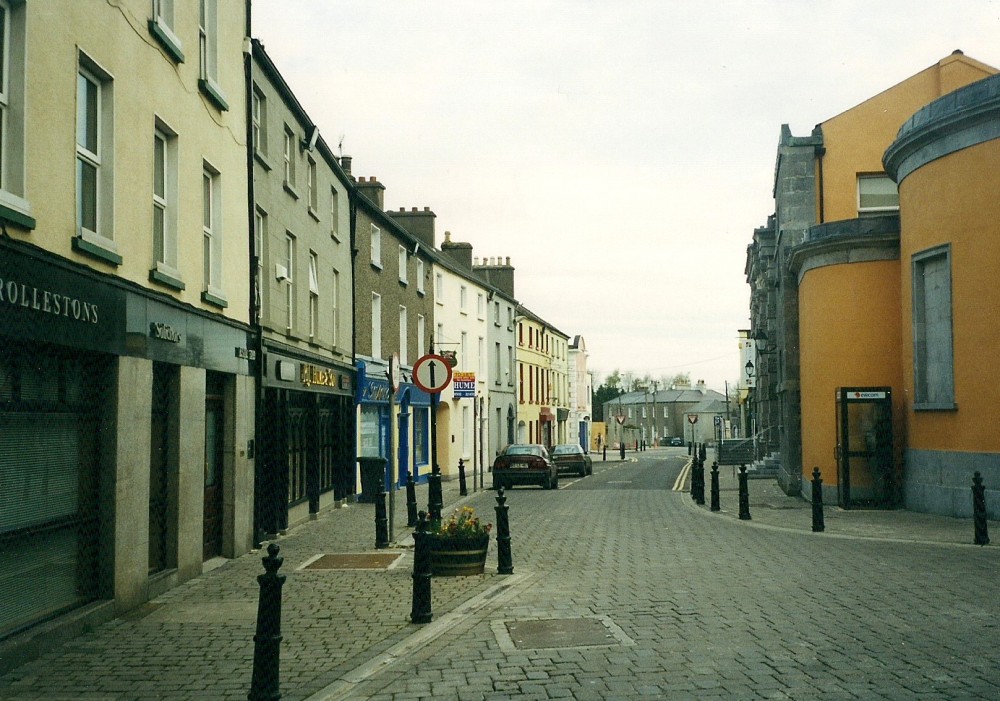By the late 1970's, after a century of service to the town, Hipwell's was closed and estate agents Clegg/Duggan opened offices here. They were succeeded by the Lombard and Ulster
Bank and then Rolleston's Solicitors.
Allured Rolleston was born in Frankfort Castle, Dunkerrin, Co. Offaly, in 1878 and in died in Ivyleigh - the former home of the Hipwell family - in 1949.
He qualified as a solicitor in 1899 (hence the date in the picture) and, shortly afterwards, unlike Griff Hinds, saw active service in the second Boer War.
After hostilities ceased in 1902, he returned to Ireland and began his legal career. His office was originally above Gannon's chemist shop further down the other
side of Main Street. He was for many years State Solicitor for County Laois, a position he held until shortly
before his death. In light of Mr Rolleston's residential and business connections with the Hipwell family, it
seems entirely appropriate that it was Griff Hinds who, as Chairman of the Town Commission, proposed a vote of sympathy with his bereaved relatives.
As can be seen in the picture, the Rolleston name stayed over the door but the business was latterly run by Philip Meagher, succeeded
by his son Gerry (Deputy Coroner for County Laois) and Eugene O'Connor (Laois Coroner).
Further down the street, Dunamaise Theatre and Arts Centre1 stands on the site of the old County Gaol which was built in 1789.
The foundation stone was laid by architect Richard Harman on the 28th of July and, according to a contemporary newspaper, when finished,
it would be "the completest building of that kind in the kingdom".
After a new gaol was opened on the Dublin Road in 1830, the building remained in use as a bridewell and police
barracks and later as a storeroom and bandroom for the Queen's County Militia. From the mid-1920's to
1994, when new premises were opened in Lyster Square, the County Library was located here.
On the wall as you entered to return your books, there was a plain wooden crucifix from the original condemned cell; a chilling reminder
of the building's former use.... During the construction of the Arts Centre, the remains of eleven people were found and reinterred
in the cemetery on the Stradbally Road.
Straight across the street from the Arts Centre are the lodge-rooms of the local Masonic Lodge. The Maryborough lodge was established in 1763 and,
in those early days, the Brethren met in an upstairs room of The Bear Inn owned by George Frost.2 Since its establishment, the lodge has occasionally been in abeyance: On the occasion of its revival in
February 1876, the Leinster Express hoped that the Grand Architect of the Universe will vouchsafe his blessing to the Maryborough masonic
lodge, that it may go on and prosper'. [For the other local paper's entirely different view of the Masons, see the forthcoming
entry on Midland House (formerly the old Post Office)]
Next door, on the corner of Jessop Street, the 'Old Church' Architects' offices occupy what was, in 1832, the Zion Chapel.
Later maps have it as 'Methodist Chapel' and, on one from 1907, it appears simply as 'Hall', having been replaced by the Church referred to in the note on the
page just before this.
1
The Official Opening of the Dunamaise by the Minister for Arts, Heritage, Gaeltacht and The Islands, Ms Síle de Valera, on 4th May, 1999 was
followed by the premiere of I’ll Fly Away, a play by yours truly.
2 On January 30 1768, The Freeman's Journal reported that "a few days ago, Mr George Frost, eminent innkeeper in Maryborough, was
thrown from his horse near the said place and killed on the spot".
If anyone knows anything about the location of 'The Bear', I'd love to hear from you.
The same applies to 'The Ship' (which I assume was also a public house?) leased from the town Corporation
by a Bartholomew Senior in the early 18th century. Great name, incidentally, for a pub in the most landlocked county in Ireland!



HOMEPAGE